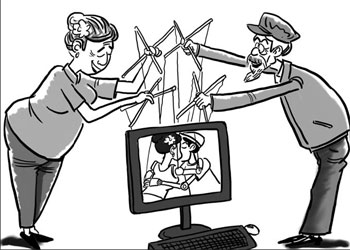China's virtual space bigger than some countries
Updated: 2007-08-24 07:06
Gartner research indicates that in four years time 80 percent of Internet users will have avatars - virtual replicas of themselves -working or playing online. Given the pace of Internet adoption, and the fact that people often have more than one avatar, there will soon be more avatars than humans, at least in the industrialized world.
How, if at all, this will change society is fascinating to predict. Dozens of companies are researching advanced versions of virtual worlds. And as computers get more powerful, screens bigger and slimmer, with high definition television around the corner, the prospects are endless.
Admittedly, the flagship of three-dimensional worlds, Second Life (SL), has been having a bad time of it this month. It had its first big financial crash when the Ginko bank failed with debts worth $700,000, leaving depositors in the real world suffering the consequences.
SL was also forced to ban gambling activities. Some commentators keep reminding us that only a small proportion of its 9 million "residents" actually come back regularly to participate.
But it faces big competition from others such as Entropia Universe, the Swedish virtual world that recently signed a deal with the Beijing municipality to build a virtual universe able to handle 7 million users at any one moment. The company believes virtual worlds could lead to people working from home in a big way.

Since barely 50,000 of SL's 9 million residents are online at any one moment, the same ratio of active to inactive users makes China's virtual space bigger than most countries in the world. The company promises "stunningly realistic graphics, environmental physics and believable animations".
It is true that SL's residents come and go but this is unsurprising since, unless you are actively involved in building, shopping or partying, then a space that is already eight times the size of Manhattan can be a pretty empty place to get lost in.
It is barely a year since SL came on to the public radar yet already there is an unstoppable momentum toward building more 3D worlds that will eventually be able to interact with each other, so an avatar in one can move in and out of a rival system.
The race to build a better virtual world is already leaving the Arctic land grab in the shadows. The winner could be Google Earth, which recently added photographs of streets to its zoom-in model of the planet. It already has 250 million users who add content and interact with each other.
It does not take a big leap of the imagination to envisage your avatar talking to friends and strangers in your own street in a few years' time.
SL, of course, is not standing still. It regularly introduces new features, such as 3D sound and the benefits of opening its code to developers has yet to be felt. But it may need a fundamental system upgrade to ward off increasing competition.
Virtual worlds are a natural space for social networks such as MySpace, Bebo and Facebook to migrate to in the future since friends can meet and chat together and maybe even watch real football matches together online.
The likes of Bebo do not think this will happen. Their plans are dominated by a mass migration of social networks to mobile phones. But in a few years - as mobile devices get bigger, lighter and smarter - they might be the natural hosts for such networks.
As Baroness Greenfield observed: "Offering people the chance to have a permanent soap opera going on in which they can participate will be even more pervasive than reality TV..."
The Guardian
(China Daily 08/24/2007 page11)
|
|
|
|
|
|